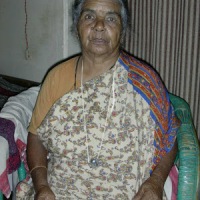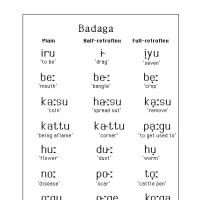Badagas call the jewellery they wear as BANGARA.
BANGARA – BADAGA JEWELLERY

Photo by Bellie Jayaprakash
Badagas, especially the women, have some exotic and unique jewellery that they wear on their person.
The main ornaments are the nose ring called ‘ MOOKUTHI ‘ and the ear ring known as ‘CHINNA’ . Chinna , literaly means gold but usually refers to ear rings. The type shown above is worn both by men and women. Of course, the ‘ BELLI UNGARA ‘ [silver finger ring] has a special place in Badaga tradition and considered to have medicinal / health benefits. On the occasion of death, silver finger rings form part of a ritual of ‘decorating the dead’.
Perhaps, it would be an interesting topic to research why Badagas have chosen these two particular designs for nose and ear rings that have not undergone any changes in ages. Is it due to their simple but very beautiful get up or are there some great hidden stories?
It was a chance but a wonderful meeting with Mrs.Gangamma, aged 78 years, daughter of Karibajja Kari Gowder of Pedduva Kallatti who was associated with Rao Bahadur Ari Gowder (’Ari Gowda koottuda maathu adile, Koodi ebba ella bae muchindu unnippa ortara endu appa hegina’, she remembers ] and wife of late Kari Gowder of Kerben Village (Kotagiri) who passed away about 40 years back, at Mettupalayam in Feb,2007.
She was wearing traditional Badaga Jewllery – ‘Mookkuthi [nose ring] & Chinna [ear ring]’ which made me ponder and wonder about Badaga Jewellery and offered me the opportunity to take her snaps with these unique ornaments.
To my great pleasure, she also has the typical tattoo on her forehead called ‘ ASALU /ASILU ‘ a tradition which is completely extinct now. She told me that the tattooing was done when she was twelve by her mother. The soot at the bottom of mud pots used for cooking in those days, was scrapped on the rim of a silver finger ring and the circular impression was first made on her forehead before being ‘pricked’ with a needle, she said.
A great sense of relief is that still there are some graceful old ladies who wear the traditional dress – thundu mundu – as well as the typical Badaga jewellery. One such lady is Mitchi Hethay from Thambatty Village. I had the great pleasure and honour to meet her and take this short video a few months back.https://www.youtube.com/embed/BiuQvc-NP-c?version=3&rel=1&showsearch=0&showinfo=1&iv_load_policy=1&fs=1&hl=en&autohide=2&wmode=transparent
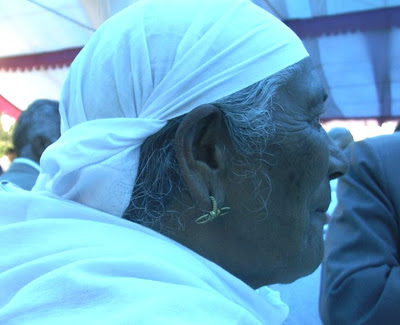


B & W Photos – Prof: Paul Hockings
Kivi Chiina – Ear Rings, worn by men. They also used to wear traditional kivi chinna.
Tattos
Notice the two rings and dots in the center of the forehead
“ Madekkeya pitti eendhu masiya belli ungaradhoge ujji nethiga haakki, adu mele soonjiya kuthidha awai. Appara urichidhamane krichi butte..adutha asilu ollagenge kuthule” ( The black soot from the bottom of a mud pot is scrapped on the rim of a silver finger ring and an imprint is made on the forehead, over which mother would ‘tattoo’ with a needle. Since it hurt a lot I cried out in pain and Mom did not prick deeper and hence the tattoo is lighter).

Above photo by Raghu Joghee
Courtesy Mr.Karia Gowder of Nattakal Village, I could take some pix of Seruppinige, Mani Maale, Sippu Bae etc, which are produced below :

Badaga women also [used to] wear a kind of chocker called “SARATTADI“ that is a short chain around the neck with a biggish pendant. Then, of course is the ‘SERUPPINIGE‘ a silver necklace / chocker.

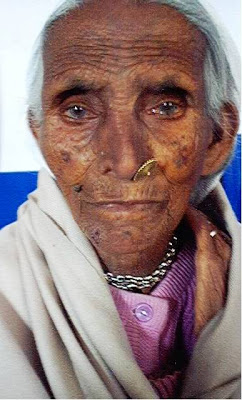

Gubbe -Mani Maaley
SARATTADI
The picture of a Badaga woman [blue blouse – bottom left ] was taken by late Chantal Boulanger-Maloney [she was a social anthropologist specializing in Indian culture and I thank her husband Peter Maloney for permitting me to use it. You can see more pictures on Badaga by Chantal in her website [other pics are by me – Bellie Jayaprakash]. The next pix is that of Mrs.Gowri wife of Rao Bahadur HB Ari Gowder and to its right is Mrs. Nanji e wife of Rao Bahadur HJ Bellie Gowder and mother of Ari Gowder. On the right extreme is Lakshmi e from Chinna (Ooru) Hubbathalai. These pictures are chosen to show the ‘SARATTADI’.
KADAGA (Bangles)
The bangle or rather bracelet around the wrist is known as ‘ KADAGA ‘ or ‘ CHIPPU BAE ‘ and the thick flat armlet just above the elbow made out of gold or silver is ‘ BAE .
When I took this picture of Kothiben Hatti Laxmi ‘Karuppi’ Hethai on 09-04-07 and mentioned that the photo has come out well, she mentioned with a great sense of humour, ‘ potto olange bandu ena maaduva, utti enbudhu tha kappu edhaga’. Thank you Kothiben Karuppi Hethe, it was wonderful meeting you !


Finger Rings known in Badaga as UNGARA
BADAGAS GIVE A LOT OF IMPORTANCE TO SILVER FINGER RINGS AND THEY ARE ALWAYS WORN IN PAIR. This is the only jewellery item that is not removed from a deceased Badaga.

My mother Idy Hethe with Janaki Akka (Hubbathalai)


ODE – DHARAY – WAIST BELT


N Bellie of Achenakal writes to mention about HODETHARA, a chain worn around the hip of a year old baby on the occassion of MANDE BEESUVA [head shaving] ceremony.
LINGA KATTI



Given below is this rare photo of Mrs. Gauri Ari Gowder, wife of Rao Bahadur HB Ari Gowder,and the eldest daughter in law of Rao Bahadur HJ Bellie Gowder, then the ‘uncrowned king of Nakku Betta’, was taken some 80/90 odd years back on her wedding day. Probably, she was the first Badaga woman to dress up in a saree for the wedding. She died very young (less than twenty) after delivery of her second female child – the epitome of beauty. Unfortunately, the baby also did not survive. The photo is given here to high light the badaga jewellery she was wearing.
The photo [from Prof : P.Hockings’ book] below is about 100yrs old. See the Jewellery
::::::::::::::::::::::::::::::::::::
:::::::::::::::::::::::::::::::::::::::::::::::::::::::::::::::::::::::::::::::::::::

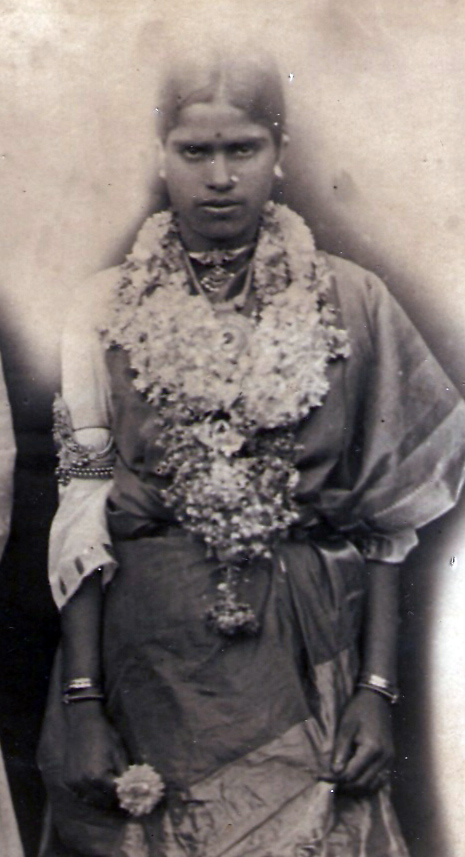











 Mookuthi
Mookuthi  Chinna
Chinna 






 ==
==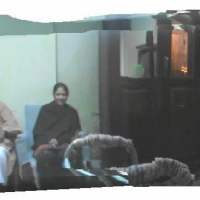
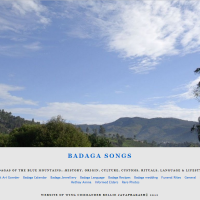

![Seemae [See'may] & Morae [Mo'ray] (relationship)](https://i0.wp.com/badaga.wordpress.com/files/2008/11/nakku-betta1.jpg?resize=200%2C200)
